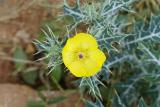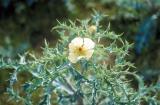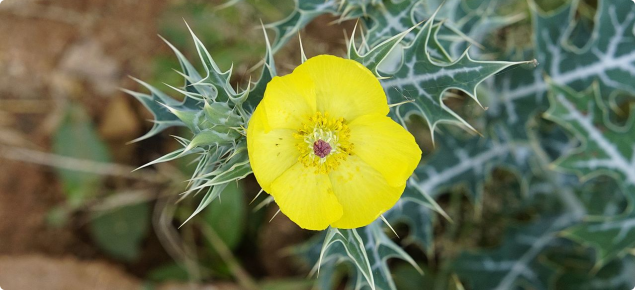Mexican poppy is the common name given to two weeds in Australia. While Argemone mexicana is a declared pest in WA Argemone ochroleuca is a widespread weed in WA and it is not declared. Although A. mexicana is pricklier than A. ochroleuca, the best way to distinguish these two species is the flower colour:
 Argemone mexicana's flower presents a bright gold yellow colour |  Argemone ochroleuca's flower is pale yellow in colour |
| People are encouraged to report Argemone mexicana |
Characteristics
Form: herbaceous – annual
Status: under eradication
Mexican poppy (Argemone mexicana) is a member of the poppy family. Its native range includes Mexico and parts of South America. It has become a weed in many countries in the Mediterranean region, Africa, Asia, the Middle East and Oceania. It is established in Queensland and New South Wales but has only been found twice in WA.
Mexican poppy is poisonous to stock, but few deaths occur because the plant is not readily eaten. This is due to its needle sharp spines and bitter yellow sap making it unpalatable. However, some stock have died after eating contaminated hay or chaff, and poultry after eating seeds. Mexican poppy seeds could be harvested with a wheat crop, thus contaminating the grain. However, the seeds are much smaller than wheat grains and are easily removed by seed cleaning. Mexican poppy infested grains are unsuitable for milling or stock feed due to their toxicity.
Mexican poppy is stiff bluish-green prickly plant usually about one metre in height but can grow up to 1.5 metres. It has large, bright golden yellow flowers, hollow stems and a seed capsule. Prior to flowering it resembles a thistle because of its toothed and prickly leaf margins. It reproduces only from seeds.
Stems: Cylindrical, pale bluish-green in colour and with scattered prickles. When broken, the stems exude a dark yellowish sap with an unpleasant acrid smell.
Leaves: Up to 15 centimetres long, green or bluish green with greyish white veins and deep regular lobes with irregularly toothed margins. The stem leaves are stalkless and clasp onto the plant's stem.
Flowers: 2.4 to 4.5 centimetres across. They have four to six golden yellow petals. The ovary at the centre of the flower is topped with a red stigma.
Seed: After fertilisation a prickly oblong seed capsule develops. This is 2.5 to five centimetres in length and two centimetres wide with four to six openings at the top. The capsule contains up to 400 seeds. The seeds are more or less spherical, brownish black, about one millimetre in diameter with a pitted surface. The seed can stay dormant for many years, making long term control difficult.
Declared pest category
The Western Australian Organism List (WAOL) contains information on the area(s) in which this pest is declared and the control and keeping categories to which it has been assigned in Western Australia (WA). Use the link on this page to reach Argemone mexicana in WAOL.
Requirements for land owners/occupiers and other persons
Requirements for land owners/occupiers and other persons if this pest is found can be sourced through the declared plant requirements link.
Search > detect > report
Report A. mexicana by using the MyWeedWatcher smartphone and tablet application or online reporting tool.
Control method
Before commencing control of Mexican poppy, report it to the Department of Primary Industries and Regional Dvelopment. Control methods for this declared plant can be found through the Mexican poppy control page.
Only registered products can be used for weed and pest control.

